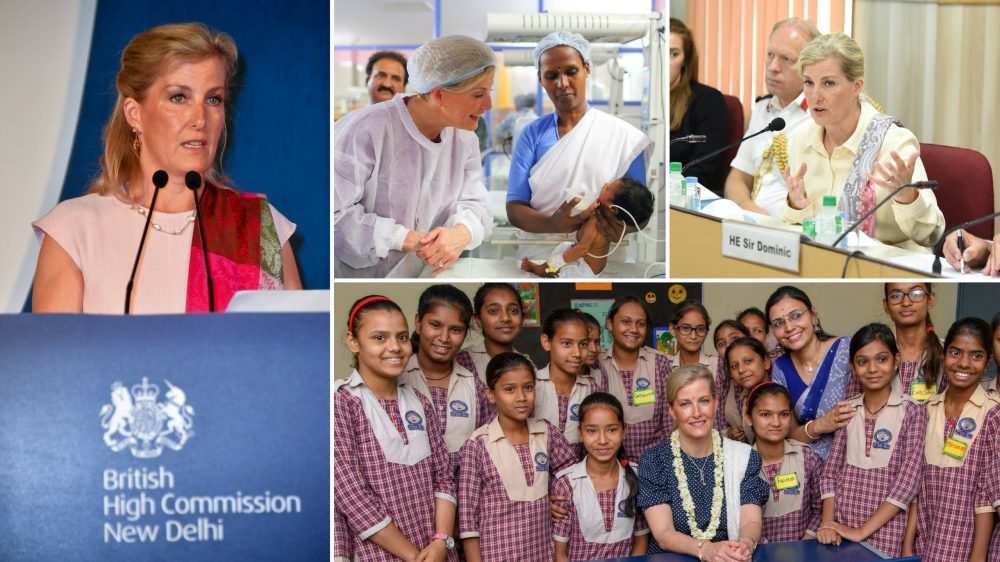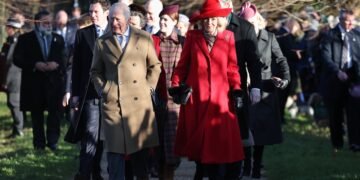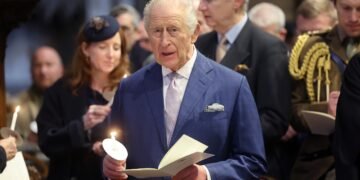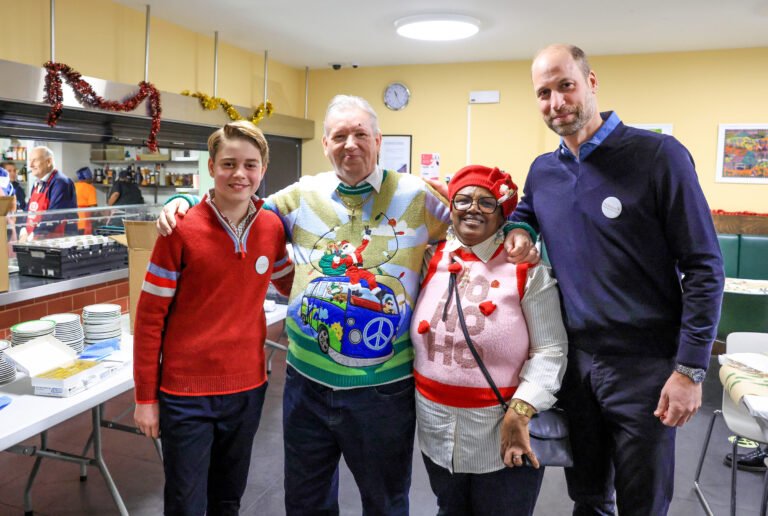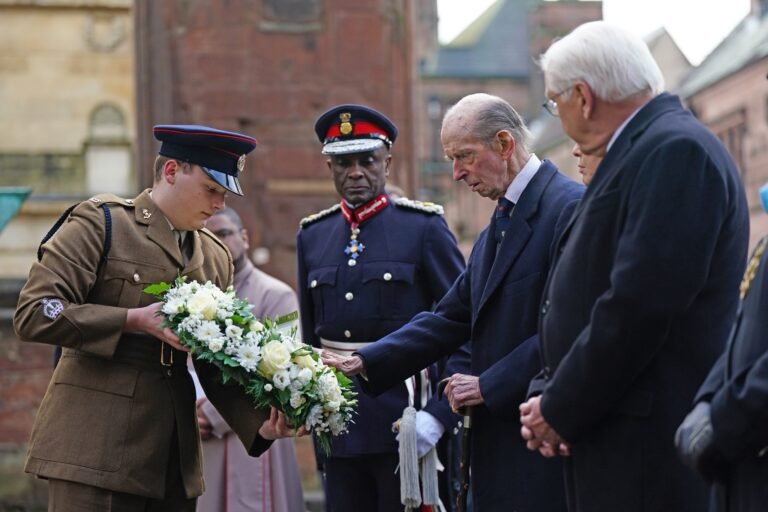The Countess of Wessex has spent most of this week in India, following the work of the Queen Elizabeth Diamond Jubilee Trust as their vice-patron. Sophie visited Hyderabad, Mumbai and New Delhi.
The trust is to be closed in January 2020, following the jubilee in 2012. It aimed to create a lasting legacy of The Queen’s, focusing on blindness and young people as leaders of the future.
Sophie left London for Hyderabad on Sunday evening, beginning her engagements on Monday. The Countess travelled to a local hospital, Gandhi Medical College, to see the work being done to prevent blindness in premature babies. India is home to the highest number of premature births in the world (26% of all births there).

Since 2007, the government in India has increased its efforts to reduce infant mortality with many more neonatal units all over the country. But as children were surviving, more and more cases of blindness in these babies were seen.
Around 20% of babies born prematurely will suffer from damaged vision, which mainly occurs in babies who are born before the 32nd week of pregnancy, or weigh less than 1.5kg when they are born.
Retinopathy of prematurity (ROP) is the leading cause of childhood blindness worldwide. The disease exclusively affects preterm babies, as the blood vessels at the back of the eye have not had a chance to fully develop before birth. Premature babies are often given oxygen in the incubator to survive, but too much oxygen is highly toxic and can lead to total and irreversible sight loss.


The Countess of Wessex donned protective clothing and met with children who had been born prematurely. She also saw the screening they are given to detect the condition and met parents waiting to have their babies screened for ROP, as well as the treatment they receive. Some of the babies weighed just 650g, and were born at 28 weeks.
Prior to 2014, there had been no national service in the country to detect ROP, as well as a lack of knowledge and understanding. The trust has been helping the Indian government to change this.

The Diamond Jubilee Trust has been working to help end avoidable forms of blindness and to empower young leaders across the Commonwealth. It has focused on tackling three major causes of preventable sight loss – blindness caused by trachoma, the world’s leading infectious cause of blindness; blindness caused by diabetes; and blindness affecting premature babies.
The ophthalmologists, paediatricians and nurses who have all been trained under the trust’s guidance met with the Royal to update her on their programme.
One doctor in particular has been a key figure in the fight against ROP: Dr Subhadra Jalali has been instrumental in the delivery of the programme, and has saved the sight of over 20,000 babies with ROP. She is now training teams across the country as well as internationally. The doctor met Sophie in London a few weeks ago at the palace, and showed the Countess the LV Prasad Eye Institute.

The Countess said: “I had the pleasure of meeting Dr Jalali a few weeks ago in London. To come here and see for myself what you are doing, is fantastic… you are creating a lasting legacy.” (1/2) pic.twitter.com/U0pKlwmp9I
— DiamondJubileeTrust (@qejubileetrust) April 29, 2019
The mother-of-two was gifted a peach traditional scarf from a doctor for her involvement in the work.
The royal visitor then joined a video conference with staff from some of those regional hospitals to hear about their experiences.
Speaking to trainees at the hospital, The Countess said: “I had the pleasure of meeting Dr Jalali a few weeks ago in London. To come here and see for myself what you are doing, is fantastic… you are creating a lasting legacy.
“The Trust has always wanted a legacy that will last on into the future and this is what you are doing. It is going to have a huge impact on the lives of thousands of children long into the future.”

Sight and blindness is one of Sophie’s areas of interest, particularly as Lady Louise, now 15, was born prematurely with a severe squint, which was corrected a couple of years ago with surgery. The Countess is a global ambassador for the International Agency for the Prevention of Blindness.
In 2017, The Queen’s daughter-in-law visited Malawi with the Diamond Jubilee Trust, to see how they are helping to eliminate blinding trachoma. In 2014, 8 million people were at risk of trachoma. Now, Malawi has removed the risk across the country.
Later that evening, the Countess attended a reception at the Taj Krishna Hotel with the British High Commissioner, to meet local graduating midwives. Babies were delivered by nurses with some midwifery knowledge. This team is the first trained solely for midwifery, making a remarkable step for maternal and neonatal health.
Congratulations to India’s first professional midwives!
The Countess met the group of nurses, now trained specifically to deliver exceptional maternity care to women and newborns, at a reception hosted by @UKinHyderabad ???? pic.twitter.com/xKV76ePtgs
— The Royal Family (@RoyalFamily) April 30, 2019
Images of HRH The Countess of Wessex @evitafernandez6 @indiek1 & @Stringer4Kate at the graduation reception of ??’s first midwives, part of #RoyalIndiaVisit. Together with @qejubileetrust these women do so much to improve lives of mothers & newborns. So proud of their hard work. pic.twitter.com/rV38ssEBfZ
— Sarah Li (@sarahliuk) May 2, 2019
She revealed to the Deputy High Commissioner’s sons that she is a Sunderland fan; the Countess is involved with the club as royal patron of their Foundation of Light charity.
On day two, Sophie visited Niloufer Hospital, where over 10,000 preemie babies are treated each year.
Previously, there was no ROP screening at the hospital. Now it is standard that all pre-term babies are screened for it. As part of her visit, The Countess of Wessex brought two donated Forus NEOs, which assist with screening. The donation came from the Diamond Jubilee Trust; eight further kits will be sent to hospitals across India.
Before the Trust’s programme launched in 2015, there were no screening & treatment services for retinopathy of prematurity (ROP) at Niloufer Hospital. Today, all preterm babies born at the hospital are screened for ROP as part of their standard care.
?@royalfocus1 @Shutterstock pic.twitter.com/nVMYpv1nTd
— DiamondJubileeTrust (@qejubileetrust) April 30, 2019
The #CountessOfWessex, Sophie Helen Rhys-Jones, visited Niloufer Hospital and Gandhi Hospital as vice-patron of @qejubileetrust. She donated two #3nethra neo cameras on behalf of the Trust, which works to prevent #visionloss in #preterm babies. #ROP pic.twitter.com/mCm29AnwVI
— Forus Health (@forus_health) May 1, 2019
There was a support group of parents with children affected by ROP, which Sophie sat in and listened to.
The Countess meets 3 year old Rishita, who was born at just 28 weeks weighing 650g, along with Dr Yadaiah who battled to save Rishita’s life and later her sight when she developed ROP.
HRH was presented with a wonderful gift showing Rishita’s journey. pic.twitter.com/KTTNAwkzeC
— The Royal Family (@RoyalFamily) April 30, 2019
The Countess met with mothers caring for their premature babies at Niloufer Hospital, Hyderabad.
? @royalfocus1 @Shutterstock pic.twitter.com/wbLFT7hgpr
— DiamondJubileeTrust (@qejubileetrust) April 30, 2019
The Royal Family instagram page posted this lovely snippet of the Countess talking with new mothers bonding with their premature babies.
Sophie left Hyderabad that evening for Mumbai. In Mumbai, the Countess’ focus was to be on young leaders who are changing their communities for the better.
She began with a visit to Sassoon Dock fish market. Here, young people are being helped by the OSCAR (Organisation for Social Change, Awareness and Responsibility) Foundation, which works to give them better opportunities by using football to promote the value of education.
The Countess of Wessex visits Sassoon Dock fish market with where some of the young people helped by @OSCAR_fdn The foundation is works to give them better opportunities #RoyalVisitIndia #Royals @ShutterstockNow pic.twitter.com/IyYkDT1j2T
— Rookie (@royalfocus1) May 1, 2019
The Countess of Wessex also met with the Ambedkar Nagar Community to see how OSCAR has helped them.
Next came a more sombre visit, heading to the memorial for the 2008 Mumbai terrorist attacks. The Countess laid a wreath at the memorial and lit a candle to remember the 174 who died.
The Mumbai attacks took place on 26 November 2008; 10 members of the Lashkar-e Taiba Islamic terrorist group carried out 12 consecutive bombings and shootings for four days around Mumbai.
Her message read: ‘In sorrow and sympathy for the families who lost their loved ones. Sophie.’
HRH The Countess of Wessex laid a wreath @TajMahalMumbai to remember the victims of Mumbai terror attacks #RoyalVisitIndia pic.twitter.com/E9ebzpD1qN
— Crispin Simon (@CrispinSimon) May 1, 2019
The Duke and Duchess of Cambridge visited the memorial, too, back in 2016.

Sophie visited a Sir Elly Kadoorie School to meet Queen’s Young Leader, Deane de Menezes. The youngster founded the project ‘Red is the new Green’, which hopes to de-stigmatise periods, improve access to menstrual hygiene and ultimately prevent female absenteeism in schools. In India, it is estimated that over 23 million girls each year drop out of school early because of menstruation.
Mothers and daughters, who had participated in awareness-raising sessions that Deane’s organisation provides, got to meet the Countess and talk about the project.

Every year 60 exceptional young leaders were chosen each year from across the Commonwealth to become Queen’s Young Leaders. Deane was in London in the summer of 2018 to be honoured by The Queen at Buckingham Palace for her work changing people’s lives.
In the school, Sophie was shown the sanitary towel-vending machines and incinerators that Red is the new Green provided. She was also given a period pouch; these are given to girls at training sessions, offering them somewhere clean and safe to keep their pads.
The Royal also filmed a short video reflecting on her time in Hyderabad; watch below.
Watch The Countess of Wessex reflect on her time in Hyderabad seeing how @qejubileetrust and its partners are stopping premature babies from needlessly going blind. pic.twitter.com/8dU498UjhQ
— The Royal Family (@RoyalFamily) May 1, 2019
Queen’s Young Leader Aditya Kulkarni also met with The Countess of Wessex at Padmanagar Apnalaya Health Clinic. He created the ‘Care Mother’ antenatal app, which is being used to help reduce maternal and child mortality rates in India. Globally, around 800 women die every day of preventable causes related to pregnancy and childbirth, of which 20% are in India; the app enables medical staff to provide antenatal check-ups to women in areas with limited resources.
The Countess spoke with health workers and mothers, and heard how the app has helped over 30,000 women from disadvantaged communities in India access antenatal care.
Globally, around 800 women die every day of preventable causes related to pregnancy & childbirth.
Aditya co-created @caremotherindia, an app which enables health workers to provide antenatal check-ups to women in areas with limited health resources.
?@royalfocus1/@Shutterstock pic.twitter.com/VzB1fgtTiE
— DiamondJubileeTrust (@qejubileetrust) May 1, 2019

That evening, Sophie was welcomed to New Delhi by another British Deputy High Commissioner. He hosted a dinner for the royal visitor and invited other influential women from the area.
Delighted to welcome HRH The Countess of Wessex to Mumbai on second leg of #RoyalVisitIndia. Welcome dinner with three remarkable women who contribute so much to this amazing city (+ my remarkable wife)
@RoyalFamily and @qejubileetrust pic.twitter.com/t2R5LcLhnN— Crispin Simon (@CrispinSimon) May 1, 2019
Sophie began this leg of the visit by heading to the United Services Institution of India. The Countess joined a roundtable discussion looking at the country’s approach to Women, Peace and Security and addressing gender-based violence in conflict, to see how the UK and India could better work together to address the issues.
Earlier this year, Sophie pledged her support to champion the UK’s efforts in the Women, Peace and Security agenda (WPS) and the Preventing Sexual Violence in Conflict Initiative (PSVI). This was why she was in New York recently, and she spoke about what she had heard and discussed whilst there.


Part of the day saw the 54-year-old learn about the Women on Wheels initiative, which empowers young women from poorer communities to become professional drivers to enable them to have better employment opportunities.
Later that evening, the Countess joined the British High Commissioner in hosting a reception to celebrate the collaborative efforts to advance eye health in India.
She gave a speech, discussing the progress that has been made in that area supported by the trust. Prince Edward’s wife

The reception additionally recognised the preparatory work of the Vision Catalyst Fund, inspired by the work of the Diamond Jubilee Trust, which will see public and private sector organisations with expertise in eye health working together to accelerate change and expand universal eye health across the globe.
Speaking at the reception in New Delhi, and making reference to a film highlighting the fight to tackle blindness in premature babies, the royal mother-of-two said: “This is the third time I have seen this film A Life with Sight and each time I see it it makes me cry.”

“My daughter, Louise, was born prematurely and so every time I see anything to do with premature babies it takes me back to those early days, the shock of her early arrival, and then the realisation that she had a sight issue,” Sophie said.
“I have seen many people both young and old have sight restored to their unseeing eyes. It is when their sight is restored that they start to smile, for smiling is a reflex we only use in response to something or someone, but it is a thing of real beauty.
“As Mother Teresa said ‘Let us always meet each other with the smile, for the smile is the beginning of love.’ I therefore ask you to help us create as many smiles as we can in order that we can spread the love.”

You can read the full speech here.
The final day of the tour saw the Countess visit Sarvodaya Kanya Vidhyalaya, Delhi Government School. She was welcomed with a traditional bindi painted on her forehead and a floral garland.
This visit was not related to the jubilee trust, but to see the local community as The Queen’s representative, and celebrate the cooperation between British Council and Delhi Government on the ‘Changing Moves Changing Minds’ programme, which aims to improve gender equality.
Sophie visited various classes to see how the children were getting on, and even participated in an arm wrestle with one pupil (who won!).


Part of the visit saw the Countess entertained by school children with performances of dance from various age groups.
The Countess then headed to the home of Mahatma Ghandi, now the Mahatma Ghandi Museum (Gandhi Smriti) in Mumbai.
Inside the museum, Sophie learnt about Ghandi’s life and work, trying to bring about change for the Indian people against British rule as leader of the Indian independence movement. He is also known as Bapu to the Indian people, as well as Father of the Nation.
The Hindu leader was assassinated in 1948, being shot point blank.

She paid homage to the political activist, by sprinkling petals on his memorial, walking barefoot.
The Royal also signed the visitor’s book to mark her visit.

Sophie was given some books on Ghandi’s life and miniature spinning wheel, like that used by the late man himself.
The final event of this visit was a reception at the British High Commissioner’s Residence, to celebrate remarkable Indian women. Sophie was welcomed with a song performed by Ankita Jaiswal. We do not have any pictures of this event we can share unfortunately, but you may see a few snaps here.
The Countess later flew back to the UK, concluding a very successful visit.

